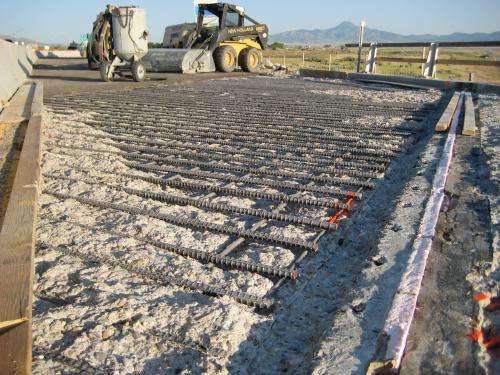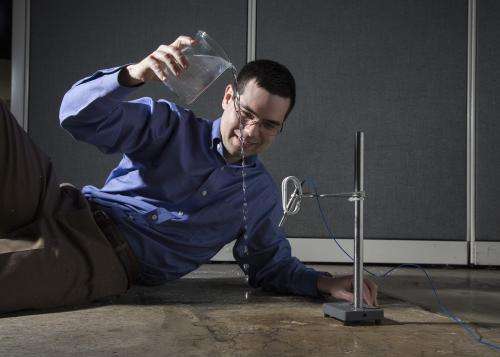How highway bridges sing—or groan—in the rain to reveal their health

A team of BYU engineers has found that by listening to how a highway bridge sings in the rain they can determine serious flaws in the structure.
Employing a method called impact-echo testing, professors Brian Mazzeo and Spencer Guthrie can diagnose the health of a bridge's deck based on the acoustic footprint produced by a little bit of water.
Specifically, the sound created when a droplet makes impact can reveal hidden dangers in the bridge.
"There is a difference between water hitting intact structures and water hitting flawed structures," Mazzeo said. "We can detect things you can't see with a visual inspection; things happening within the bridge itself."
The study presents a more efficient and cost-effective method to address the mounting safety concerns over bridge corrosion and aging across the U.S. and beyond.
While impact-echo testing for bridges is nothing new to engineers, the BYU researchers are the first to use water droplets to produce acoustic responses. Current testing relies on solid objects such as hammers and chains.

The idea is to detect delamination, or the separation of structural layers, in a concrete bridge deck. The most common method involves dragging a chain over a bridge and marking spots where dull, hollow sound is produced.
However, this method can take hours to carry out for a single bridge and requires lane closures that come with additional complications.
"The infrastructure in the U.S. is aging, and there's a lot of work that needs to be done," Guthrie said. "We need to be able to rapidly assess bridge decks so we can understand the extent of deterioration and apply the right treatment at the right time."
The study results, published in the October issue of Non-Destructive Testing and Evaluation International, could help transform deck surveys into rapid, automated and cost efficient exercises.

The method is as simple as dropping droplets of water on the material and recording the sound. The acoustic response indicates the health of the concrete.
"The response gives you an indication of both the size and the depth of the flaw," Mazzeo said.
Mazzeo said the method could be used to test materials beyond bridges, including aircraft composites, which are susceptible to delamination.
Though the current research is preliminary, the researchers envision a day where bridge deck surveys would take only a few moments.
"We would love to be able to drive over a bridge at 25 or 30 mph, spray it with water while we're driving and be able to detect all the structural flaws on the bridge," Mazzeo said. "We think there is a huge opportunity, but we need to keep improving on the physics."
Provided by Brigham Young University
















